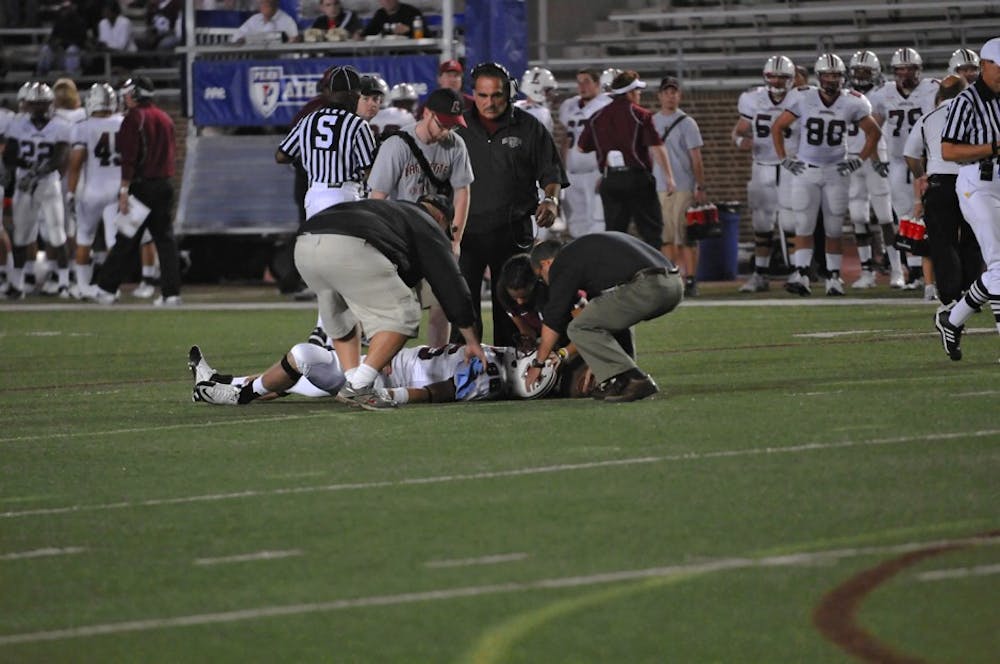
This Thursday, Rev. Katherine Brearley, mother of former Penn football player Owen Thomas, will testify before the House Education and Labor Committee about legislation that would safely manage concussions in student athletes.
Thomas, who committed suicide in April, was recently found to have a neurodegenerative brain disease linked to head trauma in athletes.
Several states including Pennsylvania have pending legislation that aims to instate more strict return-to-play guidelines following diagnosed concussions in students.
With Thomas’ case turning attention toward the consequences of head trauma in younger athletes, The Daily Pennsylvanian spoke with Charles Thompson, head athletic trainer at Princeton, to discuss concussion protocol at the collegiate level.
Daily Pennsylvanian: Do you think the Ivy League or NCAA would benefit from stricter guidelines on return-to-play protocol after suffering a concussion?
Charles Thompson: I don’t believe in the prescribed amount of time because every single one of these [cases] is different from another one.
It’s almost like snowflakes; no two are the same. I don’t want to practice medicine for the people at Penn. The NCAA doesn’t want to practice medicine and I don’t blame them for that.
I think it’s something where each individual institution needs to establish a firm protocol and stick to it — based on the science. They have to make a judgment on their athletes on their own.
You can’t make a judgment on somebody if you’re not evaluating them firsthand. It’s just like any other injury. No one’s going to say, “You have an ACL injury so you have to sit out for this many months.” Everyone’s a little different.
DP: Is there an established protocol at Princeton for dealing with a player who appears to have received a head injury?
CT: There’s twenty-something symptoms we check. If you have any of the symptoms, you’re not going back in the game. Headache, pressure in the head, neck pain, nausea, vomiting, dizziness — you’re not going back in. If you can’t tell us what month it was, you’re not going back in the game.
If they do well on this test, we would hold them for about 15 minutes and then we would repeat the test. After the initial injury, they can be very lucid and seem like they’re fine, but then they start to deteriorate a little bit later.
DP: How do you deal with a player who doesn’t admit to symptoms?
CT: If you don’t know about it, it’s very hard. I’ve been doing this for 30 years and the awareness factor has increased tremendously with everybody across the board.
Probably over the last few years I’ve had more athletes report to me that another athlete was having a problem. There are times when somebody wouldn’t report, but when you look at them or you talk to them you realize that they’re having a problem.
We had an athlete come in yesterday who said, “I had symptoms for a week and I never reported it.” And he had pretty significant symptoms. He had been coming in for other things and I had no idea he had been having an issue. That’s the inexact science part of it.
DP: If a player has suffered a concussion, what steps need to be taken before he can return to play?
CT: The following day we would repeat the symptom checklist. Then, usually after 48 hours we would do another impact test. We also do a series called paper and pencil tests.
Then we take all that information from those tests and we have a consultant — a neurophysiologist — that we send the information to and allow him to evaluate the person.
If they pass those tests right away, then they have to stay symptom free to return. When their symptoms are gone, then we can start them on some light cardio, biking, to see how they react to the exercise.
They never return to their activity until they pass their neuropsychological test and they are symptom-free.
The Daily Pennsylvanian is an independent, student-run newspaper. Please consider making a donation to support the coverage that shapes the University. Your generosity ensures a future of strong journalism at Penn.
DonatePlease note All comments are eligible for publication in The Daily Pennsylvanian.




